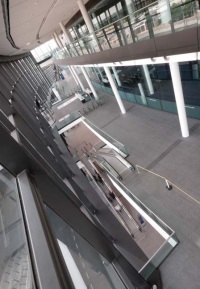Wembley stadium’s integration of building, safety, fire, security and business systems
It had a problematic birth but now Wembley stadium’s performance is world class. Much of its success lies in the complex integration of all its building, safety, fire, security and business systems, as Jane Fenwick reports.
EVERYTHING ABOUT THE NEW WEMBLEY STADIUM IS ENORMOUS—from the spiralling cost that topped £757m to the larger than life-size statue of English football hero Bobby More and the dramatic steel arch that has become a new landmark visible across London.
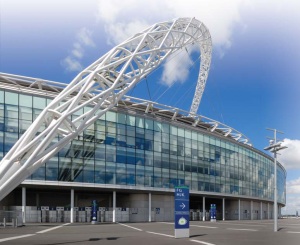
The stadium was designed to be special—to be the ultimate in stadium design with facilities to match, taking the comfort of fans and visitors to a new level. Much bigger than its predecessor, Wembley stadium is a business in its own right with facilities equivalent is size to a small town. The 90,000 seat arena is surrounded by corporate and visitor facilities stacked five and six storeys high around its 1km circumference. Within this are four of the largest restaurants in London, with huge kitchens to match in which up to 250 chefs work at one time producing high quality catering for small groups through to 1,000 people at conferences and over 3,000 for receptions.
Even if English football fans cannot always rely on the performance of their team, at least they can depend on the stadium in which it plays. Wembley is a ‘business critical’ site. With up to 90,000 attending high profile events often watched simultaneously by millions more around the world, failure to perform is not an option. Furthermore, in this age of terrorism Wembley stadium is a potential target and there is a responsibility on all concerned for the safety and security of people both inside and outside the venue.
All this was taken into account on the drawing board when integration of the stadium’s various control systems was made a key feature of the design. The client, Wembley National Stadium Limited (WNSL), the company that redeveloped the old stadium site, wanted system integration involved in the building design from the beginning, to reap the benefits both in terms of capital costs and operational savings by integrating all the technical services onto a single network. Wembley became the largest integration project in the UK and has, it is claimed, produced the most technically advanced stadium in the world.
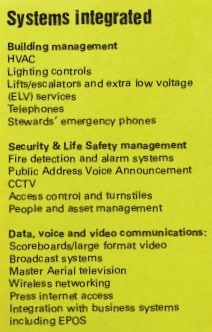
WNSL was clear that it want flexibility in its new stadium to host not only football but a range of other sports, music events and even the Race of Champions, a motor racing spectacular to be held in December this year. It also wanted interoperability and efficiency to maximise the business opportunities arising from the stadium’s activities. Integrating building, security and life safety systems along with data, voice and video communications for the entire stadium on one common network was its goal from the start. This, it felt would provide a safer, more secure and more comfortable venue and bring better building control with consequential lower operating costs. Furthermore, the intelligent control system would have to support new and improved operations and services over the life of the stadium.
These integrated technical systems were also integrated with the stadium’s business systems including its 900 EPOS (electronic point of sale) terminals, supply chain and payroll systems. This enabled quality management information to be supplied that ensured the stadium management could maximise its return on investment.
Selected as main controls contractor, Honeywell Building Solutions (HBS) designed, installed and commissioned the stadium’s core automation controls incorporating the heating, ventilation and air conditioning, lighting, lifts and escalators, telephones, fire alarms, public address/voice announcements (PA/VA), CCTV, access control and turnstiles, and people/asset management. It also masterminded implementation of the large format video, master aerial television, the broadcast systems, wireless networking, press internet access and integration with the stadium’s business systems such as the supply chain and HR database.
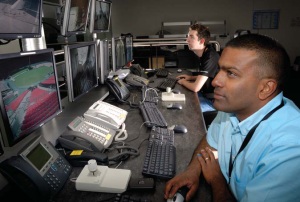
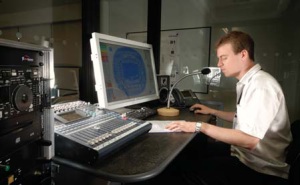
Honeywell Network Services designed and installed the IT network platform that is capable of supporting all the applications encountered in the intelligent building solution. This required the installation of 1,617km of cabling comprising 753km of fibre backbone, 234km of broadcast cabling and 630km of horizontal structured and fire rated cabling. This supports the resilient backbone and ensures that IP communication is provided with the necessary bandwidth in all operational modes of the stadium. It links 72 communications rooms which are not more than 90m apart to accommodate fast data transfer and house the network switches for 7,500 network points and 3,500 devices on the network. It also facilitates the linking of stadium operations to its parent organisations such as the FA, the internet, and via a second control room, to the Metropolitan Police and other emergency services.
The size and high profile nature of Wembley Stadium contributed in no small part to the complexity of this project. Honeywell’s integration expertise pulls all the different applications together into one, common operating platform—Honeywell’s Enterprise Buildings Integrator (EBI), which is accessed via networked PCs in workstations located in the event, security and police control rooms. Providing for day-to-day control of all stadium technical operations, EBI is linked to a bespoke Stadium Control System also designed by HBS. This governs 192 Building Management Systems which monitor and control 6,000 heating, lighting, ventilation and air conditioning devices while the security system manages digital video images from 190 CCTV cameras—including inputs from cameras outside the stadium owned and operated by the Metropolitan Police.
This system also monitors and controls access through all doors and turnstiles within the facility as well as all lifts and escalators. Crowd messaging is relayed via the digital PA/VA system and large format video screens located throughout the stadium. The fire alarm system secures communication throughout the stadium in the event of fire. This includes 80 emergency stewards’ phones linked via a dedicated fire rated cable network.
Honeywell’s experience in integrating systems in stadium environments stretches across the world from Stadium Australia in Sydney to the Emirates Stadium in London, and it is currently working on the Olympic stadium under construction in Beijing. Through this experience it recognises that stadium networks have to perform effectively 24/7 with no downtime. All elements must work together seamlessly and be resilient enough to cope in the unlikely event of failure of a critical element. Furthermore, the IT and FM aspects of the operation have to integrate and work closely together, as well as with the event management teams and the Police and other emergency services.

The hub of the event day operations is in two control rooms. The normal compliment of 20 Honeywell resident engineers on non-event days who would normally monitor the systems in the control room, swells to up to 50 on major event days. Banks of screens monitor different aspects of the building constantly.
In the daily ‘at ease’ routine, the Honeywell team checks all Honeywell maintained technical services prior to and during events. They man the event and security control rooms checking cameras are functioning properly, verifying all fire alarm panels are operating correctly on mains and battery voltages and checking the PA/VA systems and backup power.
The systems can be ‘pre-programmed’ for each event. For example, areas not in use can be closed off or limited to ‘permitted access’. The security system can also read tickets to allow the holder in only once—stopping tickets being handed back through the turnstiles to friends. Counterfeit tickets alert security to the turnstile. The ticket holder is let in only to be apprehended by security on the other side. Lifts and escalators can be controlled centrally to ensure smooth inflow or outflow of visitors and individual or banks of turnstiles can be opened or closed automatically.
On match and event days, the Metropolitan Police man their control room working closely with the event management. They can take control of the CCTV system if required to facilitate closer crowd control for full control of crowd management inside and outside the stadium, and too and from the local transport hubs. For example, across the site there are 200 CCTV camera giving excellent coverage within and around the stadium, all connected to a system that can be alarm triggered, controlled and monitored by the control room or managed by the Police on match and event days. Furthermore from the control rooms, cameras in the nearby streets, train and underground stations and even key points across London, can be monitored. Voice systems include not only the fire systems but also the stewards phone system and the business telephone system.

It cost about £21m to install the infrastructure to support the integration of the building systems. This, Peter Orr, Honeywell’s Business Development Director Network Services, explained, is more expensive than not integrating the systems but the costs is fully outweighed by the benefits of integration which could not be achieved through the traditional construction contractual route. He estimated that Wembley can expect 28 per cent saving through integration on operational costs. These can be achieved primarily through energy savings, particularly the ease of closing down areas of the building not in use and through the simplicity of changing the configuration of the stadium for its different uses. Specialist staff would normally be employed to reconfigure access control, security systems, etc, for each event but this can now be done automatically and centrally from the control room.
Furthermore, integration of building and business systems opens up the possibility of Wembley developing new business streams. By using the stadium’s wireless network for example, it can link mobile phone bar codes with EPOS applications and capitalise on new income-generating opportunities—such as enabling fans to order drinks for the interval from their seats.
Since the old Wembley was demolished in 2002, software has moved on and Orr expects that the Windows 2000 platform employed at Wembley will be upgraded in due course.
Wembley Stadium’s IT and Business Process Director, Peter Warren, supports pulling the different technical systems together into one integrated solution because it centralises data and enables the stadium operators to make sense of a lot of information quickly. He explained, “They can access the entire system via a PC screen and manage all of the technical services in the stadium from a small number of work stations located in critical locations such as the Event, Security and Police control rooms. IP convergence lifts the system’s intelligence higher still. It enables us to enhance customer service, link to EPOS and leverage new revenue generating opportunities—now and in the future. The EBI enables automated building control processes to perform on the basis of all the information available within the different applications, and management has the ability to satisfy seemingly conflicting goals—to increase productivity yet reduce costs while delivering all the services needed by a world class stadium conferencing and banqueting centre.
“Integration allows us to do more with less—to drive productivity improvement, validate for regulatory compliance, set new benchmarks in respect of customer service and deliver on our financial goals and all against the backdrop of a safe, secure, comfortable and energy efficient stadium. It’s an investment that will serve the UK very well for many years to come.”

